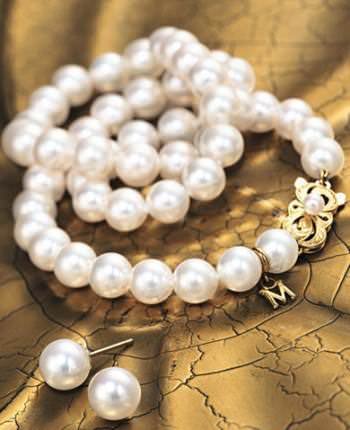Tokyo—A new akoya pearl farm venture located in an open-sea area in Japan’s Fukuoka Prefecture has yielded a bounty of “excellent pearls” of large size and good quality, with owner K. Mikimoto and Co. citing the harvest as a major advance in pearl cultivation for the much-prized pearl variety.

|
| Akoya cultured pearls |
“The results have been astounding at this new akoya pearl farm,” the company said in a release shared exclusively with National Jeweler, describing Mikimoto Hakata Pearl Culturing Co.’s pearl farm in Ainoshima, Fukuoka Prefecture, Japan. “While the number of large-sized Japanese akoya pearls of the highest quality has been decreasing in recent years, Mikimoto can now continue to ensure its stable supply at [the pearl farm in] Ainoshima, heralding a new beginning for both Mikimoto and the jewelry industry as a whole.”
The akoya pearl industry has been struggling with scarcity for more than a decade, ever since Japan’s akoya pearl-producing oyster population was decimated back in the mid 1990s by what experts believed was a mix of factors including pollution, disease and a 1994 “red tide” that brought microscopic, toxin-producing animals into the waters where pearl oysters were harvested.
Since that time, the Chinese freshwater pearl industry has been growing rapidly with the quality of its pearls improving in turn, although Japanese akoyas, particularly in the 6- to 7-millimeter size range have remained coveted commodities.
This past winter at Ainoshima, pearls were harvested from 10,000 akoya pearl oysters that had been raised to maturity over the past four years. Nearly 12,000 pearls harvested exhibit the high quality for which Mikimoto pearls are renowned, with high luster and good color unique to Japanese akoyas, the company said.
“Cultivating pearls using native oysters in this area heralds an important new advance in Japanese pearl production, at a time when the amount of high-quality akoya pearls is feared to be decreasing,” the company said.
Mikimoto Hakata Pearl Culturing Co., a subsidiary of K. Mikimoto and Co., was founded in January 2007 with the goal of launching a new akoya cultivation business, using home-grown, disease-free, natural pearl oysters discovered in Ainoshima in 2000. The company’s research laboratory, K. Mikimoto and Co. Ltd. Pearl Research Laboratory, has been working with scientists from the Fukuoka Fisheries and Marine Technology Center, Kyusuu University and Shingu Ainoshima Fisheries Corp. on the pearl-culturing project at Ainoshima.
Although the pearl farm is young, its harvest was a surprise because of the unusually high percentage of good-quality pearls. The success is being attributed to “thorough preservation” of the farm environment, where oysters enjoyed favorable living conditions during the culturing period. The goal for 2010 is to harvest pearls from 50,000 akoya oysters, with the number of oysters to be harvested expected to grow to 200,000 within the next three years, the company said.
One thing that sets the new farm apart is its location in the open sea, since it was previously assumed that closed, calm waters were best for pearl production, the company said.
Source: www.nationaljewelernetwork.com










